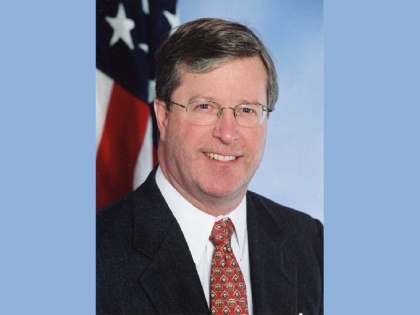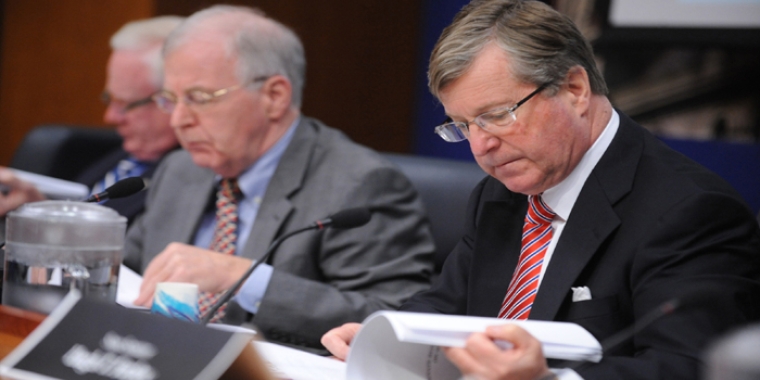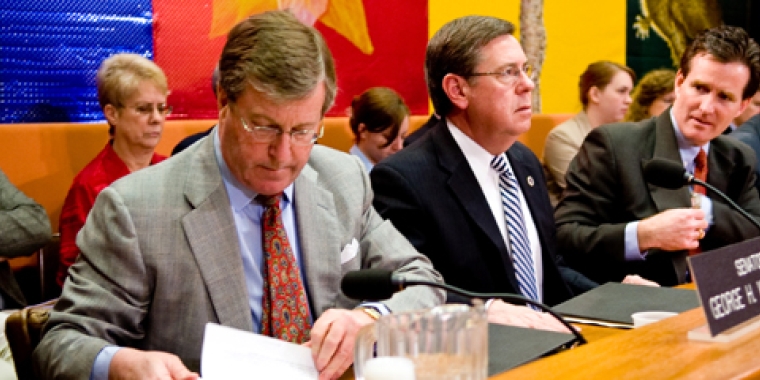
Local Government Efficiency
George Winner
We’ve made progress over the past several years that I’ve been serving in the State Senate to begin, we hope, putting the brakes on runaway local property tax increases. But there’s a long way to go.
New York’s school property tax relief program, commonly known as STAR, now provides $5.1 billion in property tax relief annually. This fall marked the second consecutive year of our direct property tax rebate program. Beginning in 2006, a cap on local Medicaid costs has been widely credited for restraining increases. Under the cap, the state is relieving localities of additional Medicaid costs above a growth rate of 3.5 percent last year, 3.25 percent this year and 3 percent next year and in subsequent years. The state Health Department recently announced that this year the cap will produce nearly $200 million in Medicaid cost savings for localities, including more than $1.7 million in savings for Steuben County.
But the issue of high property taxes continues to rankle, rightly so. Medicaid costs remain extraordinarily high in New York. We’re hopeful that a new Medicaid Inspector General -- once that office is running at full throttle -- will begin to crack down on the abuse, fraud, and waste that plagues the system and thereby further, and we believe significantly, ease the burden on property taxpayers. And while short-term responses like STAR and direct property tax rebates are necessary, it’s imperative that we begin to also approach the issue from a long-term perspective. So the state-level Commission on Property Tax Relief has worked throughout the past year and recently issued a final report detailing recommendations on how best to provide a fundamental, long-term restructuring of a tax burden that’s become too hard to handle for too many homeowners. We must also explore additional Medicaid reform, local government efficiency, mandate relief, public school financing, and economic development -- all of which affect the property tax burden.
Local government efficiency is getting some noteworthy attention as well, and it’s going to be a hot-button issue in 2009. That’s because last year a new Commission on Local Government Efficiency & Competitiveness was created to study how New York’s 4,200 local governments can provide public services more efficiently and more cooperatively as part of the effort to bring down local property taxes.
The 15-member, interagency panel has also issued a final report, "21st Century Local Government."
As expected, it's already sparking worthwhile debate.
In the executive summary of its report the commission, chaired by former Southern Tier Congressman Stan Lundine whose members included Tom Tranter, Jr., president and director of government affairs for Corning Enterprises, and former Chemung County executive, stated, "To make real progress in containing our local property tax burden, aggressive service consolidations and government restructuring are needed. This is a complex undertaking, and one that will require a continuing partnership with local governments and an ongoing effort across many state agencies. State and local programs both need to be reviewed on a continuing basis."
The commission has estimated more than $1.1 billion in cost savings to local governments through the implementations of its recommendations, including measures aimed at:
-- centralizing some services at the county level or between counties, such as tax collection, vital records, and jails;
-- making it easier for municipalities to form cooperative health benefit plans for their employees as a way to reduce insurance costs;
-- facilitating local shared-services agreements for the provision of highway services;
-- allowing counties to join together to employ a single public health director;
-- setting up restructuring committees to examine service sharing and consolidation within local schools; and
-- easing the procedures for the consolidation of towns and villages.
The overriding goal, of course, is to undertake local government efficiency and competitiveness initiatives as a key part of the overall effort to reduce the local property tax burden, particularly across the upstate region. Toward this end, I believe "21st Century Local Government" continues to stand as a blueprint for legislative action that can help bring down local property taxes by encouraging greater government efficiency.
Reactions to the commission's report have been positive. The state Association of Counties, Council of School Superintendents, and Business Council, for example, issued support for various recommendations. Of course, there will be opposition and resistance too.
But it's a beginning. Together with the report from the Commission on Property Tax Relief, a necessary debate within New York government has been fully framed.
These concepts and ideas have been kicked around since I can remember, but now we've consolidated them, put them all together in the same room, so to speak, so that we can once and for all air the concerns, settle differences, recognize the reality, and, most importantly, start to act.
I've long been an advocate of shared services at the local level. We know that many of this area's local leaders, such as Chemung County Executive Tom Santulli, have recognized the value of cutting costs at the local level through consolidations, shared services, and the like.
"It is incumbent upon us to seek out ways to provide tax relief to our overburdened property taxpayers," Mr. Santulli has said.
The fact is that shared services and other local government efficiency initiatives have to play an increasingly important role in the ongoing, comprehensive effort to keep property taxes under control. We need to keep encouraging these options for localities looking for ways to cut costs and ease the local tax burden. We simply can’t overlook -- and, in fact, should be doing everything we can to encourage -- the potential for local governments to take their own steps toward greater efficiency and cooperation.
Share this Article or Press Release
Newsroom
Go to Newsroom
Winners Renews Call for More Medicaid Reform
June 15, 2010


